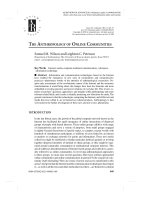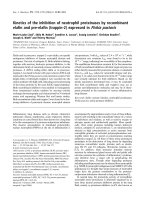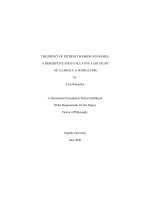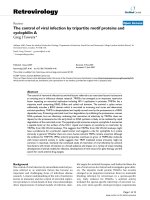The economics of sports 5th by michael a leed and allmen chapter 10
Bạn đang xem bản rút gọn của tài liệu. Xem và tải ngay bản đầy đủ của tài liệu tại đây (1.94 MB, 44 trang )
The Economics of Sports
FIFTH EDITION
Chapter 10
Discrimination:
Theory,
Measurement, and
Consequences
MICHAEL A. LEEDS | PETER VON ALLMEN
Introduction
• Jackie Robinson became the first black player in
MLB’s modern era (NL; hired by manager Branch
Rickie)
– 1946—Montreal Royals
– 1947—Brooklyn Dodgers
• Larry Doby became the first black in the AL (hired
by Bill Veeck)
– 1947—Cleveland Indians
• It is remarkable that Robinson and Doby flourished
despite the tense atmosphere in which they played
Copyright ©2014 Pearson Education, Inc. All rights reserved.
10-2
Learning Objectives
• Understand the Becker model of discrimination
• Describe how various forms of discrimination can
occur in professional sports
• Evaluate gender discrimination in college sports
Copyright ©2014 Pearson Education, Inc. All rights reserved.
10-3
Empirical Studies and Definitions
• A major study finds that all players face the same
opportunities in MLB, NFL and NBA
• Some economic studies find that there are differences in
pay in the NBA as well as European soccer
• They also find evidence of discrimination in the NFL draft
• We need to distinguish between
– Prejudice -- a feeling or emotion
– Discrimination -- an action
• Economists separate two issues
– Equal access to work (draft order)
– Equal pay for equal work (equal salaries to equally
talented players in same positions)
Copyright ©2014 Pearson Education, Inc. All rights reserved.
10-4
10.1 Becker’s Theory of
Discrimination
• Gary Becker (1957) uses neoclassical theory to
analyze and evaluate discrimination like any other
“good”
– Neoclassical theory assumes that people
maximize utility subject to constraint
– Economists focus much more on the outcome of
discrimination than on its origin
• Becker considers prejudice a taste
– Discrimination is indulging that taste
– This indulgence comes at a cost
• We can reduce discrimination by raising its cost
Copyright ©2014 Pearson Education, Inc. All rights reserved.
10-5
10.2 Different Forms of
Discrimination
• This section introduces
– Employer Discrimination
– Employee Discrimination
– Consumer Discrimination
• Although each model uses money to measure the
intensity of the discrimination, they are all based on
utility maximization
• As people with a taste for discrimination maximize
their utility, their willingness to pay to indulge their
tastes has a variety of effects
Copyright ©2014 Pearson Education, Inc. All rights reserved.
10-6
Employer Discrimination
• In Becker ’s model, employers have preferences regarding
employees with whom they do and do not want to
associate
• There have been many studies of discrimination against
French-speaking hockey players (Francophones)
– Their findings depend in many cases on the players’
positions
• To simplify matters, assume that there are only two groups
of players
– English-speaking (E) and French-speaking (F)
• We assume for now that, although the players’ styles may
differ, they are equally productive
– They have the same MPL
Copyright ©2014 Pearson Education, Inc. All rights reserved.
10-7
Employer Discrimination
• If a hockey team owner dislikes Francophones,
employing them brings a psychic cost
– He feels that he pays them more than others
– The perceived wage is
• wF = (1+dF)wE
– dF = discrimination coefficient (%)
• If the employer pays both F and E the same, he
feels as if he is paying F more
• As a result, the demand for F falls
Copyright ©2014 Pearson Education, Inc. All rights reserved.
10-8
Employer Discrimination
• Assume for simplicity that the supply of both
players is the same
• Panel b in Figure 10.1 indicates that the wages of
both kinds of players will be the same
• Panel a in Figure 10.1 indicates that with
discrimination, the demand for Francophones falls
– At any given wage, the employers’ distaste for
them reduces their willingness to hire them
• As a result, F’s wage falls relative to E’s
– WE > WF
Copyright ©2014 Pearson Education, Inc. All rights reserved.
10-9
Figure 10.1
Copyright ©2014 Pearson Education, Inc. All rights reserved.
10-10
Who Wins and Who Loses:
Summary
• Francophone players lose
– Pay is lower and fewer are employed (Figure10.1)
• Anglophone players win
– Pay is higher and more are employed
– Less qualified workers are hired
• Unequal pay for equal work results
• Prejudiced employers lose
– Francophones’ lower pay offsets psychic cost
– Employers pay more for worse players
Copyright ©2014 Pearson Education, Inc. All rights reserved.
10-11
Statistical Discrimination
• What if productivity differs across the two groups?
• Group statistics may indicate nothing about
individual performance
• The use of group averages to judge individual
productivity is called statistical discrimination
– Employers may use it if obtaining individual
information is costly
• Small differences in group statistics can have a
strong impact on a team’s hiring practices and may
result in decisions that look like taste discrimination
– Statistical discrimination may generate a selffulfilling prophesy
Copyright ©2014 Pearson Education, Inc. All rights reserved.
10-12
Does Anyone Win with Employer
Discrimination?
• Consider the case of racial discrimination in MLB
• Blacks were effectively barred from organized
baseball from 1888 to 1947 by a “gentlemen’s
agreement”
• One group that benefited from discrimination was
white players of that era
• More white players played in the major leagues than
would have been possible otherwise
• Figure 10.2 reflects the result of assuming that there
is a large supply of white players (deep pool of
talent) willing to play at market wages—no blacks
are hired
Copyright ©2014 Pearson Education, Inc. All rights reserved.
10-13
Figure 10.2
Copyright ©2014 Pearson Education, Inc. All rights reserved.
10-14
Segregation Results
• The Negro League owed its existence in part to such
discrimination
– The league effectively folded once the major
league integrated
• Figures 10.3 shows the market for Negro League
• Demand (DS) was much higher before integration (DI)
• Figure 10.4 shows the MLB market
• Demand (DI) rose after integration (DS)
• Tastes of consumers changed, both blacks and whites
Copyright ©2014 Pearson Education, Inc. All rights reserved.
10-15
Figure 10.3
Copyright ©2014 Pearson Education, Inc. All rights reserved.
10-16
Figure 10.4
Copyright ©2014 Pearson Education, Inc. All rights reserved.
10-17
Competition Can Eliminate
Discrimination
• Unprejudiced employers have an advantage over
prejudiced employers
– They hire more productive players (and get higher
revenue if consumers and employees are not prejudiced)
– They do not have to pay as much as teams with
Anglophones
– They have higher profits
• As more unprejudiced employers enter, or as more people
worry about profit than taste
– Pay of Francophones is driven up
– Pay eventually equals those of Anglophones
• Perfect competition eliminates discrimination
Copyright ©2014 Pearson Education, Inc. All rights reserved.
10-18
Competition and Discrimination
• In the 1950s, integrated teams were better
– Dodgers, Giants, Indians, Braves, and White Sox
were dominant teams
• Dodgers and Giants won pennants
– Only the Yankees were good and remained white
• Owners had recognized black talent but could not
act on it
• MLB kept Bill Veeck from buying the Phillies in 1943
– Veeck had wanted to hire Negro League players
– He was the first to integrate AL with 1947
Cleveland Indians
Copyright ©2014 Pearson Education, Inc. All rights reserved.
10-19
When Markets Are Not
Competitive
• In competitive markets, discriminated players work
at a discount
• We will now assume that the market for labor is not
competitive—it is a monopsony
• The standard model is presented in Figure 10.5
• Without discrimination, the employer pays the same
low wage (found on the supply curve) to all players
– In this figure, the wage is $800 while the value of
the player is $1000
Copyright ©2014 Pearson Education, Inc. All rights reserved.
10-20
Figure 10.5
Copyright ©2014 Pearson Education, Inc. All rights reserved.
10-21
Figure 10.6
Copyright ©2014 Pearson Education, Inc. All rights reserved.
10-22
Monopsony Model with
Discrimination
• Figure 10.6 shows the wages paid to F players
• It assumes that
– F players are more productive than E players, so
F players are worth $1500 rather than $1000 that
E players receive (for example)
– Employers discriminate against F players, which
shifts the demand curve from D to D’
• F players are paid more than E players
($960>$800)
• F players are paid less than they are worth because
of monopsony power and because of discrimination
Copyright ©2014 Pearson Education, Inc. All rights reserved.
10-23
Employee Discrimination
• Employees with a taste for discrimination regard the
market wage, w, as w(1 - dj)
– dj represents the coefficient of discrimination for
employees
– They feel like they are being paid less
• In 1880s, a few blacks played in the American Association
– The first was Moses Fleetwood Walker for Toledo in 1884
– Cap Anson, a dominant player for Chicago White
Stockings, played in an exhibition game against Toledo
team with Moses Fleetwood Walker
– Next year he had a contract not to include black players
– White players drove blacks out of MLB by 1888
Copyright ©2014 Pearson Education, Inc. All rights reserved.
10-24
Employee Discrimination History
• Attempts to reintegrate MLB started after WWII
even as employee discrimination was rampant
• The Dodgers traded 5 players for Al Gionfriddo &
$100,000, a marginal player, who was willing to
take the locker next to Robinson (& “carry the
money”)
• In 1947, Dodger players circulated a petition
refusing to play with Robinson
• Dodgers manager, Leo Durocher, called a late-night
meeting and (in an exquisite speech of which there
are different versions) said
– See the next slide
Copyright ©2014 Pearson Education, Inc. All rights reserved.
10-25









